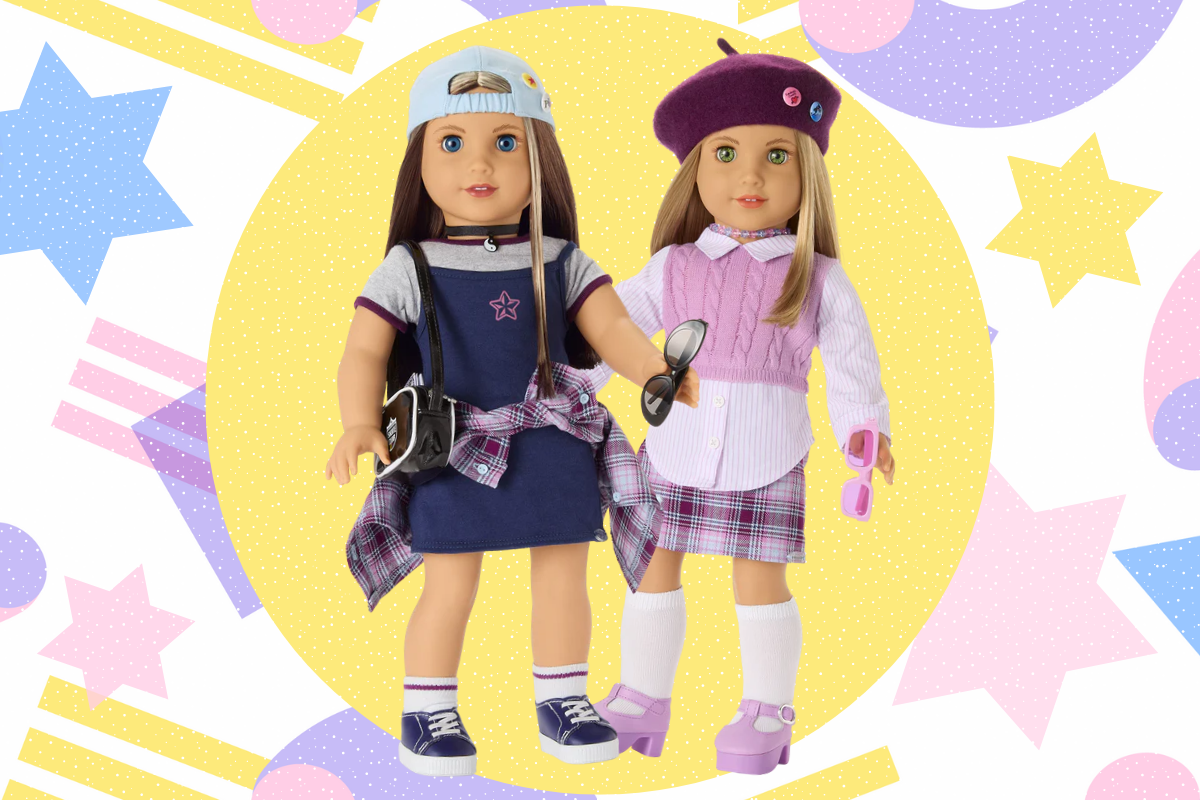Well, it finally happened. This week, American Girl announced ‘90s historical dolls, twins named Nicki and Isabel Hoffman. Yes, the ‘90s are now a historical era, complete with dolls that can live next to your Mollys and Samanthas. The dolls draw clear inspiration from the Olsen twins and the movie “Clueless.” And, because treating the ‘90s as a historical era isn’t upsetting enough, American Girl decided to bring back, along with portable CD players and Y2K, the kind of Jewish representation I overwhelmingly remember growing up: one that’s barely there.
Buzz about these dolls, and their Jewishness, have circulated for months. Blogs dedicated to the tracking of American Girl trademarks first noted last year that among other things, the company had filed a trademark application for “Nicki Cohen” and “Isabel Cohen,” before ultimately landing on the surname “Hoffman.”
While this is not unusual — American Girl frequently files trademarks they do not ultimately use — to me it was the first sign of trouble. Because what is the difference? What does Hoffman have that Cohen doesn’t?
It turns out, what it has is plausible deniability, the overarching theme of this entire collection.
American Girl has made a series of disappointing choices here. The dolls are white and pale, with light, straight hair. There is no mention of the dolls being Jewish in any of the promotional materials initially released. The website’s product description of Isabel’s accessories describes Isabel’s butterfly bedroom lights as a “Christmas gift” from her sister Nicki. The Pizza Hut accessory includes a pepperoni pizza. There is not a single reference anywhere on the website to the dolls being Jewish or being from an interfaith household, except, if you have eagle eyes, a sample page of Nicki’s book (for this collection, American Girl has foregone the traditional “Meet” books of years past for character “journals” more akin to the Amelia books, for those who remember them, or “Diary of a Wimpy Kid”) and the product description of the pet cat and dog, which describes them as Hanukkah gifts.
Now to be clear, of course there are blonde Jews, Jews who eat pepperoni pizza and Jews from interfaith households. The problem here is that American Girl has completely abandoned the pretense that these are educational toys and have buried the Jewish identities of these dolls deep enough that it can be ignored.
There was a time when American Girl treated its historical collections as educational opportunities. Occasionally, it still does. Last year’s new historical release, Claudie Wells, is a girl growing up during the 1920s Harlem Renaissance whose collection included a more traditional “meet book” written by best-selling author Brit Bennett that offers a new window on Black American life beyond the historical eras it previously explored.
And American Girl knows how to do this for Jewish characters, when it wants to. I have long considered their first historical Jewish doll, Rebecca Rubin, a girl growing up in 1914 on the Lower East Side, to be a gold-standard for mainstream commercial Jewish representation. When Rebecca was released in 2009, her collection included a Hanukkah set, a samovar, Shabbat candlesticks, challah, rugelach and bagels. Her books were filled with Jewish cultural content, from depictions of holidays from fresh angles to labor activism to Hebrew and Yiddish. And while yes, Jews look all sorts of ways, the choice to make Rebecca olive-complexioned and give her dark, curly hair was important because Jewish girls who do look like that do not regularly get the affirmation from culture at large that they are beautiful or that their features are desirable, and do not have many options in terms of dolls who look like them (ask me how I know!).
This is the reason that I’ve always championed Rebecca Rubin, and why I find these new dolls so frustrating. I look at these dolls, modeled on the Olsen twins, and all I see are missed opportunities. This was a chance to give a kid who doesn’t get tons of options an option. This was a chance to give a kid who does have lots of options a window into something new. The books are set in Seattle, which in addition to being the home of grunge, is also home to one of the largest Sephardi communities in the United States. Why not make them Sephardic? If the twins are meant to be interfaith, why does that mean they have to be white? Why not make them Jews of Color? Growing up in this era, most Jews I knew were, like myself, children of immigrants or else immigrants themselves. Why not make the twins Persian Jews? Or Syrian? Argentine? Recent emigres from the Soviet Union? Why, of all the stories one could tell about a Jewish family in 1999, was this the one?
This was also a chance to give us something fresh with regard to Jewish material culture. There’s endless ways to develop culturally specific, fun and beautiful Jewish material culture and content, and this used to be the whole point of historical dolls in the first place. We’ve never gotten holiday or ritual objects that weren’t for Shabbat or Hanukkah. We’ve never gotten so much as a t-shirt from a Jewish summer camp, arguably one of the most formative Jewish experiences most American Jews have. This collection hasn’t even made the bare minimum effort. Why did no one consider making it a veggie pizza from Pizza Hut? Why did no one think that maybe the collection’s pets could have been named “Falafel” or “Kugel” instead of “Buffy” and “Blossom”?
When none of these opportunities are seized, to me it says that American Girl does not think there is a Jewish story worth incorporating here. That there is no cultural specificity that needs to be accounted for, no potential educational opportunity to be had. Knowing what American Girl is capable of doing, this is profoundly disappointing. In 2023, it’s simply not enough.



